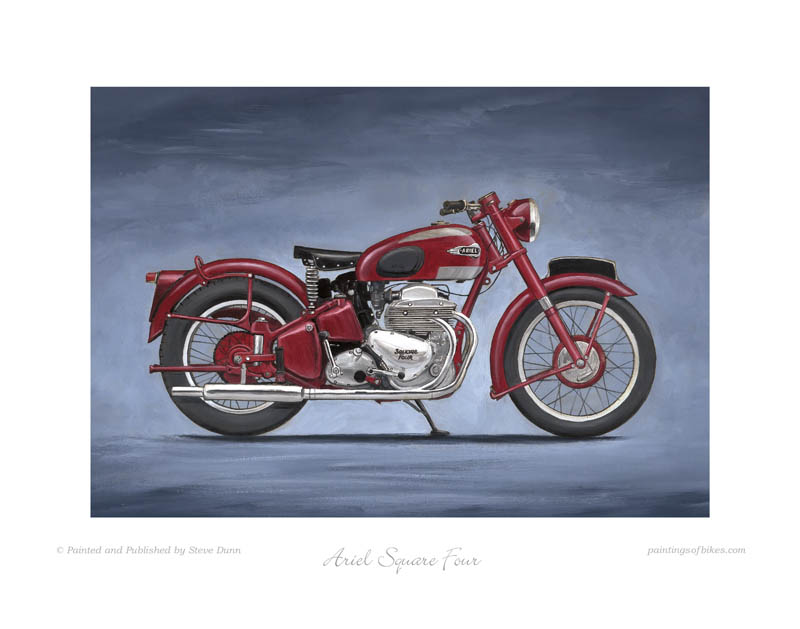OnlineMotorcyclist.co.uk
----Home Page > Motorcycle Marque History > Ariel History
|
|||||
A Brief History of Ariel MotorcyclesIf you like this page, please share it with your friends on Facebook by clicking the button below. In 1871, James Starley went into partnership with William Hillman to build bicycles. Hillman later became well known for his motor car company. They developed a light weight bicycle frame of the Penny Farthing design to which their wire spoked
wheels were fitted. Charles Sangster had been a successful engineer at Swift. In 1895, Sangster planned a new company making components for the cycle trade. Components Limited was formed with financial backing from Harvey du Cros Jnr. who
was already the finance behind Dunlop and Swift. Dunlop tyres were fitted to virtually all makes of bicycle produced in the UK. In 1896, Dunlop resurrected the Dunlop
Cycle Co. and resumed bicycle production. Sangster took on the Dunlop cycle division, leaving Dunlop to concentrate on tyre design and manufacture. The Ariel name was with Swift but was soon transferred to Components Ltd. Ariel was then registered as a trade name under which Dunlop bicycles were
produced. In 1901,
Ariel introduced a bicycle frame fitted with a 211cc Minerva engine fastened to the frame
downtube. From 1910, Ariel used single cylinder side valve engines based on the White and Poppe design. These were made right through to 1925 with some of them being built for military use in World War I. Engines used by Ariel around this time included Swiss built MAG engines and British built JAP and Abingdon (later Abingdon King Dick) V-twins. In 1925, Val Page joined Ariel as a new designer. Val was a talented engineer who had previously worked at J.A. Prestwich (JAP). Page designed new engines for 1926. Ariels made between 1926 and 1930 were known as 'Black Ariels'.
The 500cc Ariel Square Four engine, designed by Edward Turner, first appeared at the 1930 Olympia Show ready for the 1931 season. In 1932, the capacity of the Square Four was increased to 600cc. In 1932, Components Ltd. went bankrupt. In 1936, Jack Sangster bought the Triumph motorcycle concern. In 1937, a redesigned
Square Four overhead valve engine of 995cc with iron barrels and head was
introduced. In 1939, Anstey link plunger rear suspension was an option. It was still available when production restarted after World War II, when telescopic forks replaced the girder forks. Ariel had been involved in various military projects during the war including the manufacture of a military motorcycle, the 350cc Model W / NG based on the earlier Red Hunter. In the late 1940s, Ariel introduced a 500cc OHV twin cylinder machine known as the KH. In 1951, Jack Sangster sold Ariel and Triumph to the Birmingham Small Arms Company group (BSA) and became a member on the BSA board. At the beginning of the 1950s an alloy engined version of the Square Four was introduced. This was known as the Mk I.
In 1954, Ariel introduced the
650 Huntmaster. Also in 1954, the Ariel Colt was introduced. This was a 200cc four stroke machine. For 1954, with the exception of the Square Four, the Ariel range had the option of the Pivoted Rear Fork frame. The Square Four remained in a plunger frame until production ceased in 1959, however, in 1957, a prototype Square Four Mk IV was produced featuring a swing arm frame. In 1956, Jack Sangster became the new Chairman of the BSA group. In 1957, Edward Turner became head of the automotive division which then included Ariel, Triumph and BSA motorcycles. In 1959, the BSA group took
the decision to stop all four stroke production for the time
being, and the Ariel Leader was introduced. In 1963, BSA closed the Selly Oak works and transferred all production to Small Heath. In 1963, the 50cc Ariel Pixie was introduced. This featured a version of the BSA Beagle four stroke engine reduced from 75cc to 50cc. In 1964, a 200cc version of the Arrow was introduced. Ariel ceased motorcycle production in 1966, although the BSA group used the Ariel name once more on the Ariel 3, a three wheeled 50cc two stroke moped. Production of the Ariel 3 was short lived and was dropped along with the Ariel name shortly afterwards.
|
